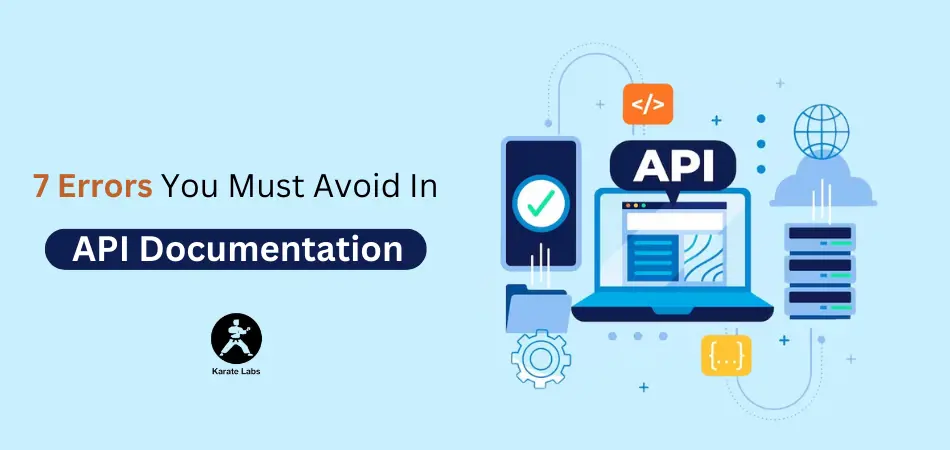7 Errors You Must Avoid In API Documentation

API documentation is a critical component in the world of software development. It serves as the bridge between developers and the functionality of an API, guiding them through the integration process. API Documentation, or Application Programming Interface Documentation, provides developers with the details they need to effectively and correctly use an API (Application Programming Interface). An API is a set of rules and protocols that allows different software applications or systems to communicate with each other.
However, even the most well-intentioned and meticulously crafted documentation can fall prey to various errors and pitfalls. These errors hinder developers and can lead to frustration, misinterpretation, and, in some cases, application failures. This guide will explore seven common and impactful errors that an API documentation example must diligently avoid. By understanding these pitfalls, we aim to help API providers ensure that their documentation remains clear, accurate, and a valuable asset to the developer community.
What is API Documentation?
API documentation plays a pivotal role in simplifying the integration process for developers, allowing them to understand the API's functionalities and requirements. However, errors and shortcomings in API documentation can lead to confusion, hinder progress, and, at worst, result in failed implementations. APIs serve as intermediaries that enable different software systems to communicate with each other, allowing for the exchange of data and functionalities. API documentation is the user manual for developers, offering detailed insights into the API's structure, capabilities, and usage.
Why is it Necessary to Avoid Mistakes?
API documentation is not merely an optional accessory to an API but an integral and indispensable part of the developer experience. Mistakes or errors in API documentation can have significant repercussions for both API providers and developers. Here are some compelling reasons why it is imperative to avoid the mistakes in API documentation:
- Developer Productivity:
Errors or ambiguities in documentation can impede developers' progress. When developers encounter unclear or inaccurate information, they spend more time troubleshooting and deciphering the documentation than on actual development. Precise and accurate documentation accelerates the integration process and enhances developer productivity.
- Reduced Support Overhead:
Flawless documentation can significantly reduce the need for extensive developer support. When documentation is precise and comprehensive, developers can independently self-serve and find solutions to their problems. Reducing support overhead not only saves resources but also improves the developer experience.
- Avoid Misinterpretation:
Developers rely on documentation to understand how the API functions and implement it correctly in their applications. Errors or ambiguities in documentation can lead to misinterpretation, which, in turn, results in incorrect usage of the API. This disrupts the development process and introduces potential security risks or data inaccuracies.
- Developer Trust and Satisfaction:
High-quality, accurate, and up-to-date documentation builds trust and satisfaction among developers. It signals a commitment to transparency and a positive developer experience, which can encourage developers to choose and continue using the API.
- Preventing Costly Mistakes:
Document errors can result in costly mistakes for developers. For instance, developers may incur unexpected expenses if an error in rate limit information leads to increased usage and charges. Clear documentation helps prevent such financial pitfalls.
- Enhanced Collaboration:
In cases where multiple developers or teams collaborate on a project, well-documented APIs are essential for effective communication and understanding. Errors in the documentation can lead to misunderstandings and hinder collaboration.
- Security and Data Integrity:
Document errors can lead to security vulnerabilities or data integrity issues. Developers rely on the documentation to understand security best practices and data handling. Inaccurate information can lead to accidental security breaches or data loss.
- API Adoption and Success:
The success of an API often hinges on its ease of use and the developer experience. Accurate documentation is a vital component in driving API adoption and achieving long-term success in the market.
7 Errors You Need to Avoid in API Documentation
API documentation is a crucial resource for developers, serving as their guide to understanding, utilizing, and integrating an API. The quality of this documentation profoundly impacts the developer experience. To ensure that the API documentation example remains a valuable asset rather than a source of frustration, we must address and rectify common errors that can lead developers down the wrong path.
- Incomplete Endpoints: A Roadblock for Developers
Endpoints are the gateway to an API's functionality, and incomplete information about them can impede developers. API providers should thoroughly document all endpoints to address this error. This includes the most common and primary endpoints and those that are less frequently used. Each endpoint should be described in detail, explaining its intended purpose, the kind of data it deals with, and any specific requirements. Additionally, the supported request methods (e.g., GET, POST, PUT, DELETE) for each endpoint should be clearly stated.
- Lack of Clear Examples: Confusion in Implementation
Clear and practical examples are the bedrock of API documentation. They serve as real-world illustrations of how developers should structure their requests and interpret responses. To avoid the error of unclear examples, API providers should offer a variety of use case scenarios with accurate and up-to-date code samples. These examples should cater to different programming languages to accommodate a broad audience. Clear and concise explanations should accompany each example to ensure developers can readily understand and replicate the processes.
- Unclear Request and Response Details: The Devil in the Details
Request and response details constitute the heart of the API documentation example. These details should be corrected to avoid confusion, misinterpretation, and implementation mistakes. API providers should define the structure of requests and responses, specifying the data format (e.g., JSON, XML) and detailing the expected parameters or fields. Additionally, they should indicate data types, acceptable values, and any applicable constraints. Including examples of both successful and erroneous responses with explanations can be immensely helpful to developers in understanding potential issues and their resolutions.
- Inadequate Authentication and Authorization Guidance
Authentication and authorization are the cornerstones of API security, and any deficiencies in this aspect of documentation can result in errors and security vulnerabilities. To prevent this error, API providers should furnish a step-by-step guide that elucidates how developers can obtain the credentials or tokens required for authentication. The documentation should specify the authentication mechanisms the API supports (e.g., API keys, OAuth) and offer detailed instructions on their implementation. Emphasizing the importance of safeguarding sensitive information and providing recommendations on best practices for secure authentication and authorization procedures is essential.
- Deprecated Endpoints and Features: Leading Developers Astray
Deprecated endpoints and features are a potential landmine for developers. If API providers fail to communicate which parts of the API have been deprecated clearly or will be phased out, developers might inadvertently use outdated functionalities. To avoid this error, API documentation should include a dedicated section highlighting deprecated endpoints, features, or functionalities. It should specify when these items were deprecated, offer alternatives or migration paths, and advise developers on updating their implementations accordingly. Providing clear deprecation notices helps prevent developers from investing time and effort into using no longer supported features.
- Lack of Error Handling Information: Navigating the Unknown
APIs are bound to encounter errors at some point, and developers need to know how to handle these errors gracefully. Only complete or present error-handling information can leave developers navigating the unknown, unsure of how to respond to mistakes when they occur. To address this error, API documentation should provide a comprehensive list of possible error codes, each with a clear explanation and guidance on troubleshooting and resolving the issue. Code examples that illustrate handling different error scenarios can be beneficial. By offering robust error-handling information, API providers empower developers to react effectively when things go awry.
- Inconsistent or Outdated Documentation: Lost in Translation
Inconsistency and outdated documentation information can make developers feel lost and confused. This error manifests in the documentation as either inconsistent in formatting or structure or ancient, not reflecting the current state of the API. To avoid this error, API providers should maintain a consistent format and installation throughout the documentation, ensuring that all sections are well-organized and follow a clear pattern. Additionally, they must commit to keeping the documentation up to date. As the API evolves, the documentation should evolve in parallel, reflecting any changes, new features, or deprecations. A clear update history or change log can help developers understand what has been modified.
Nullify API Documentation With Karate Labs
At Karate Labs, we recognize the paramount significance of API documentation and its role in your journey to building robust, reliable, and successful applications. Karate Labs is proud to offer an open-source Unified Test Automation Platform that empowers you with comprehensive API testing and API performance testing capabilities. Our platform is designed to meet the diverse needs of developers, quality assurance professionals, and businesses looking to ensure their APIs' reliability, efficiency, and performance.
Our platform is open-source, which means it is powerful and accessible to a vast community of users and contributors. It offers flexibility, extensibility, and adaptability to diverse testing scenarios. Whether you're testing REST, SOAP, GraphQL, or any other API type, Karate Labs' Unified Test Automation Platform is here to simplify your testing process and enhance the quality of your API implementations.






